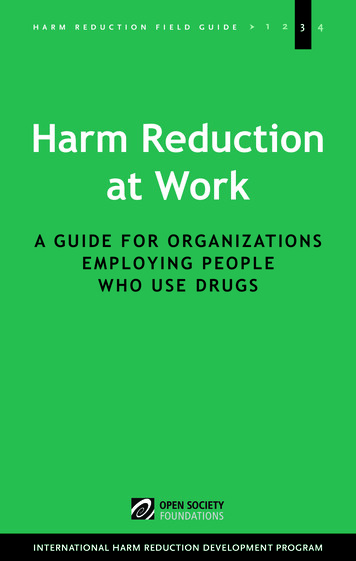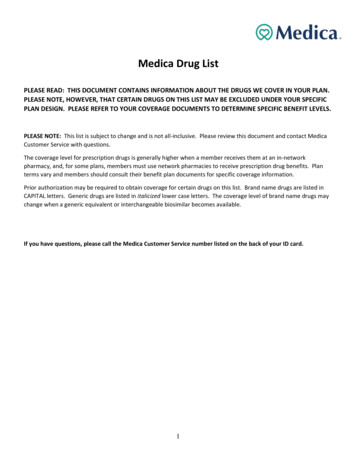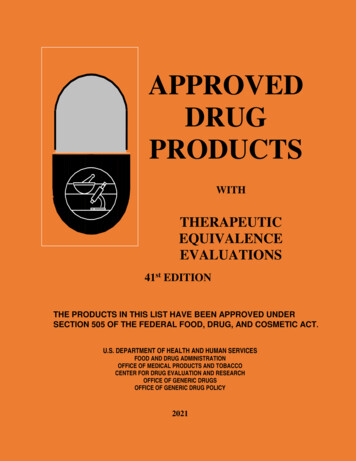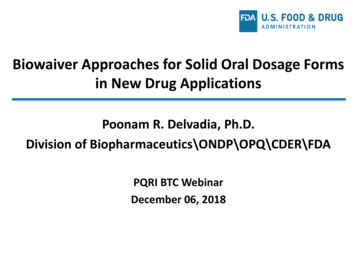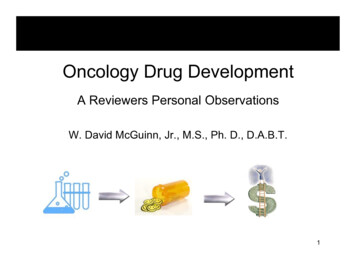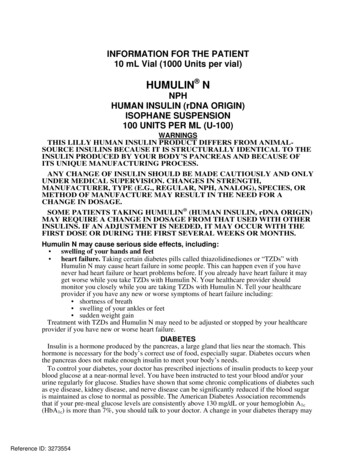
Transcription
1A3.0NL 5712 AMPINFORMATION FOR THE PATIENT10 mL Vial (1000 Units per vial)HUMULIN NNPHHUMAN INSULIN (rDNA ORIGIN)ISOPHANE SUSPENSION100 UNITS PER ML (U-100)WARNINGSTHIS LILLY HUMAN INSULIN PRODUCT DIFFERS FROM ANIMALSOURCE INSULINS BECAUSE IT IS STRUCTURALLY IDENTICAL TO THEINSULIN PRODUCED BY YOUR BODY’S PANCREAS AND BECAUSE OFITS UNIQUE MANUFACTURING PROCESS.ANY CHANGE OF INSULIN SHOULD BE MADE CAUTIOUSLY AND ONLYUNDER MEDICAL SUPERVISION. CHANGES IN STRENGTH,MANUFACTURER, TYPE (E.G., REGULAR, NPH, ANALOG), SPECIES, ORMETHOD OF MANUFACTURE MAY RESULT IN THE NEED FOR ACHANGE IN DOSAGE.SOME PATIENTS TAKING HUMULIN (HUMAN INSULIN, rDNA ORIGIN)MAY REQUIRE A CHANGE IN DOSAGE FROM THAT USED WITH OTHERINSULINS. IF AN ADJUSTMENT IS NEEDED, IT MAY OCCUR WITH THEFIRST DOSE OR DURING THE FIRST SEVERAL WEEKS OR MONTHS.Humulin N may cause serious side effects, including: swelling of your hands and feet heart failure. Taking certain diabetes pills called thiazolidinediones or “TZDs” withHumulin N may cause heart failure in some people. This can happen even if you havenever had heart failure or heart problems before. If you already have heart failure it mayget worse while you take TZDs with Humulin N. Your healthcare provider shouldmonitor you closely while you are taking TZDs with Humulin N. Tell your healthcareprovider if you have any new or worse symptoms of heart failure including: shortness of breath swelling of your ankles or feet sudden weight gainTreatment with TZDs and Humulin N may need to be adjusted or stopped by your healthcareprovider if you have new or worse heart failure.DIABETESInsulin is a hormone produced by the pancreas, a large gland that lies near the stomach. Thishormone is necessary for the body’s correct use of food, especially sugar. Diabetes occurs whenthe pancreas does not make enough insulin to meet your body’s needs.To control your diabetes, your doctor has prescribed injections of insulin products to keep yourblood glucose at a near-normal level. You have been instructed to test your blood and/or yoururine regularly for glucose. Studies have shown that some chronic complications of diabetes suchas eye disease, kidney disease, and nerve disease can be significantly reduced if the blood sugaris maintained as close to normal as possible. The American Diabetes Association recommendsthat if your pre-meal glucose levels are consistently above 130 mg/dL or your hemoglobin A1c(HbA1c) is more than 7%, you should talk to your doctor. A change in your diabetes therapy mayReference ID: 3273554
2be needed. If your blood tests consistently show below-normal glucose levels, you should also letyour doctor know. Proper control of your diabetes requires close and constant cooperation withyour doctor. Despite diabetes, you can lead an active and healthy life if you eat a balanced diet,exercise regularly, and take your insulin injections as prescribed by your doctor.Always keep an extra supply of insulin as well as a spare syringe and needle on hand. Alwayswear diabetic identification so that appropriate treatment can be given if complications occuraway from home.NPH HUMAN INSULINDescriptionHumulin is synthesized in a special non-disease-producing laboratory strain of Escherichia colibacteria that has been genetically altered to produce human insulin. Humulin N [Human insulin(rDNA origin) isophane suspension] is a crystalline suspension of human insulin with protamineand zinc providing an intermediate-acting insulin with a slower onset of action and a longerduration of activity (up to 24 hours) than that of Regular human insulin. The time course ofaction of any insulin may vary considerably in different individuals or at different times in thesame individual. As with all insulin preparations, the duration of action of Humulin N isdependent on dose, site of injection, blood supply, temperature, and physical activity. Humulin Nis a sterile suspension and is for subcutaneous injection only. It should not be used intravenouslyor intramuscularly. The concentration of Humulin N is 100 units/mL (U-100).IdentificationHuman insulin from Eli Lilly and Company has the trademark Humulin. Your doctor hasprescribed the type of insulin that he/she believes is best for you.DO NOT USE ANY OTHER INSULIN EXCEPT ON YOUR DOCTOR’S ADVICE ANDDIRECTION.Always check the carton and the bottle label for the name and letter designation of the insulinyou receive from your pharmacy to make sure it is the same as prescribed by your doctor.Always check the appearance of your bottle of Humulin N before withdrawing each dose.Before each injection the Humulin N bottle must be carefully shaken or rotated several times tocompletely mix the insulin. Humulin N suspension should look uniformly cloudy or milky aftermixing. If not, repeat the above steps until contents are mixed.Do not use Humulin N: if the insulin substance (the white material) remains at the bottom of the bottle after mixingor if there are clumps in the insulin after mixing, or if solid white particles stick to the bottom or wall of the bottle, giving a frosted appearance.If you see anything unusual in the appearance of Humulin N suspension in your bottle or noticeyour insulin requirements changing, talk to your doctor.StorageNot in-use (unopened): Humulin N bottles not in-use should be stored in a refrigerator, butnot in the freezer.In-use (opened): The Humulin N bottle you are currently using can be kept unrefrigerated aslong as it is kept as cool as possible [below 86 F (30 C)] away from heat and light.Do not use Humulin N after the expiration date stamped on the label or if it has beenfrozen.INSTRUCTIONS FOR INSULIN VIAL USENEVER SHARE NEEDLES AND SYRINGES.Correct Syringe TypeDoses of insulin are measured in units. U-100 insulin contains 100 units/mL (1 mL 1 cc).With Humulin N, it is important to use a syringe that is marked for U-100 insulin preparations.Reference ID: 3273554
3Failure to use the proper syringe can lead to a mistake in dosage, causing serious problems foryou, such as a blood glucose level that is too low or too high.Syringe UseTo help avoid contamination and possible infection, follow these instructions exactly.Disposable syringes and needles should be used only once and then discarded by placing theused needle in a puncture-resistant disposable container. Properly dispose of the punctureresistant container as directed by your healthcare provider.Preparing the Dose1. Wash your hands.2. Carefully shake or rotate the bottle of insulin several times to completely mix the insulin.3. Inspect the insulin. Humulin N suspension should look uniformly cloudy or milky. Do notuse Humulin N if you notice anything unusual in its appearance.4. If using a new Humulin N bottle, flip off the plastic protective cap, but do not remove thestopper. Wipe the top of the bottle with an alcohol swab.5. If you are mixing insulins, refer to the “Mixing Humulin N and Regular Human Insulin”section below.6. Draw an amount of air into the syringe that is equal to the Humulin N dose. Put the needlethrough rubber top of the Humulin N bottle and inject the air into the bottle.7. Turn the Humulin N bottle and syringe upside down. Hold the bottle and syringe firmly inone hand and shake gently.8. Making sure the tip of the needle is in the Humulin N suspension, withdraw the correctdose of Humulin N into the syringe.9. Before removing the needle from the Humulin N bottle, check the syringe for air bubbles.If bubbles are present, hold the syringe straight up and tap its side until the bubbles floatto the top. Push the bubbles out with the plunger and then withdraw the correct dose.10. Remove the needle from the bottle and lay the syringe down so that the needle does nottouch anything.11. If you do not need to mix your Humulin N with Regular human insulin, go to the“Injection Instructions” section below and follow the directions.Mixing Humulin N and Regular Human Insulin (Humulin R)1. Humulin N should be mixed with Humulin R only on the advice of your doctor.2. Draw an amount of air into the syringe that is equal to the amount of Humulin N you aretaking. Insert the needle into the Humulin N bottle and inject the air. Withdraw the needle.3. Draw an amount of air into the syringe that is equal to the amount of Humulin R you aretaking. Insert the needle into the Humulin R bottle and inject the air, but do not withdrawthe needle.4. Turn the Humulin R bottle and syringe upside down.5. Making sure the tip of the needle is in the Humulin R solution, withdraw the correct doseof Humulin R into the syringe.6. Before removing the needle from the Humulin R bottle, check the syringe for air bubbles.If bubbles are present, hold the syringe straight up and tap its side until the bubbles floatto the top. Push the bubbles out with the plunger and then withdraw the correct dose.7. Remove the syringe with the needle from the Humulin R bottle and insert it into theHumulin N bottle. Turn the Humulin N bottle and syringe upside down. Hold the bottleand syringe firmly in one hand and shake gently. Making sure the tip of the needle is inthe Humulin N, withdraw the correct dose of Humulin N.8. Remove the needle from the bottle and lay the syringe down so that the needle does nottouch anything.9. Follow the directions under “Injection Instructions” section below.Follow your doctor’s instructions on whether to mix your insulins ahead of time or just beforegiving your injection. It is important to be consistent in your method.Reference ID: 3273554
4Syringes from different manufacturers may vary in the amount of space between the bottomline and the needle. Because of this, do not change: the sequence of mixing, or the model and brand of syringe or needle that your doctor has prescribed.Injection Instructions1. To avoid tissue damage, choose a site for each injection that is at least 1/2 inch from theprevious injection site. The usual sites of injection are abdomen, thighs, and arms.2. Cleanse the skin with alcohol where the injection is to be made.3. With one hand, stabilize the skin by spreading it or pinching up a large area.4. Insert the needle as instructed by your doctor.5. Push the plunger in as far as it will go.6. Pull the needle out and apply gentle pressure over the injection site for several seconds.Do not rub the area.7. Place the used needle in a puncture-resistant disposable container and properly dispose ofthe puncture-resistant container as directed by your healthcare provider.DOSAGEYour doctor has told you which insulin to use, how much, and when and how often to inject it.Because each patient’s diabetes is different, this schedule has been individualized for you.Your usual dose of Humulin N may be affected by changes in your diet, activity, or workschedule. Carefully follow your doctor’s instructions to allow for these changes. Other thingsthat may affect your Humulin N dose are:IllnessIllness, especially with nausea and vomiting, may cause your insulin requirements to change.Even if you are not eating, you will still require insulin. You and your doctor should establish asick day plan for you to use in case of illness. When you are sick, test your blood glucosefrequently. If instructed by your doctor, test your ketones and report the results to your doctor.PregnancyGood control of diabetes is especially important for you and your unborn baby. Pregnancy maymake managing your diabetes more difficult. If you are planning to have a baby, are pregnant, orare nursing a baby, talk to your doctor.MedicationInsulin requirements may be increased if you are taking other drugs with blood-glucose-raisingactivity, such as oral contraceptives, corticosteroids, or thyroid replacement therapy. Insulinrequirements may be reduced in the presence of drugs that lower blood glucose or affect howyour body responds to insulin, such as oral antidiabetic agents, salicylates (for example, aspirin),sulfa antibiotics, alcohol, certain antidepressants and some kidney and blood pressure medicines.Your healthcare provider may be aware of other medications that may affect your diabetescontrol. Therefore, always discuss any medications you are taking with your doctor.Before you use Humulin N, tell your healthcare provider if you: take any other medicines, especially ones commonly called TZDs (thiazolidinediones). have heart failure or other heart problems. If you have heart failure, it may get worsewhile you take TZDs with Humulin N.ExerciseExercise may lower your body’s need for insulin during and for some time after the physicalactivity. Exercise may also speed up the effect of an insulin dose, especially if the exerciseinvolves the area of injection site (for example, the leg should not be used for injection just priorto running). Discuss with your doctor how you should adjust your insulin regimen toaccommodate exercise.TravelWhen traveling across more than 2 time zones, you should talk to your doctor concerningadjustments in your insulin schedule.Reference ID: 3273554
5COMMON PROBLEMS OF DIABETESHypoglycemia (Low Blood Sugar)Hypoglycemia (too little glucose in the blood) is one of the most frequent adverse eventsexperienced by insulin users. It can be brought about by:1. Missing or delaying meals.2. Taking too much insulin.3. Exercising or working more than usual.4. An infection or illness associated with diarrhea or vomiting.5. A change in the body’s need for insulin.6. Diseases of the adrenal, pituitary, or thyroid gland, or progression of kidney or liverdisease.7. Interactions with certain drugs, such as oral antidiabetic agents, salicylates (for example,aspirin), sulfa antibiotics, certain antidepressants and some kidney and blood pressuremedicines.8. Consumption of alcoholic beverages.Symptoms of mild to moderate hypoglycemia may occur suddenly and can include: sweating drowsiness dizziness sleep disturbances palpitation anxiety tremor blurred vision hunger slurred speech restlessness depressed mood tingling in the hands, feet, lips, or tongue irritability lightheadedness abnormal behavior inability to concentrate unsteady movement headache personality changesSigns of severe hypoglycemia can include: disorientation seizures unconsciousness deathTherefore, it is important that assistance be obtained immediately.Early warning symptoms of hypoglycemia may be different or less pronounced under certainconditions, such as long duration of diabetes, diabetic nerve disease, use of medications such asbeta-blockers, changing insulin preparations, or intensified control (3 or more insulin injectionsper day) of diabetes.A few patients who have experienced hypoglycemic reactions after transfer fromanimal-source insulin to human insulin have reported that the early warning symptoms ofhypoglycemia were less pronounced or different from those experienced with theirprevious insulin.Without recognition of early warning symptoms, you may not be able to take steps to avoidmore serious hypoglycemia. Be alert for all of the various types of symptoms that may indicatehypoglycemia. Patients who experience hypoglycemia without early warning symptoms shouldmonitor their blood glucose frequently, especially prior to activities such as driving. If the bloodglucose is below your normal fasting glucose, you should consider eating or drinking sugarcontaining foods to treat your hypoglycemia.Mild to moderate hypoglycemia may be treated by eating foods or drinks that contain sugar.Patients should always carry a quick source of sugar, such as hard candy or glucose tablets. Moresevere hypoglycemia may require the assistance of another person. Patients who are unable totake sugar orally or who are unconscious require an injection of glucagon or should be treatedwith intravenous administration of glucose at a medical facility.Reference ID: 3273554
6You should learn to recognize your own symptoms of hypoglycemia. If you are uncertainabout these symptoms, you should monitor your blood glucose frequently to help you learn torecognize the symptoms that you experience with hypoglycemia.If you have frequent episodes of hypoglycemia or experience difficulty in recognizing thesymptoms, you should talk to your doctor to discuss possible changes in therapy, meal plans,and/or exercise programs to help you avoid hypoglycemia.Hyperglycemia (High Blood Sugar) and Diabetic Ketoacidosis (DKA)Hyperglycemia (too much glucose in the blood) may develop if your body has too little insulin.Hyperglycemia can be brought about by any of the following:1. Omitting your insulin or taking less than your doctor has prescribed.2. Eating significantly more than your meal plan suggests.3. Developing a fever, infection, or other significant stressful situation.In patients with type 1 or insulin-dependent diabetes, prolonged hyperglycemia can result inDKA (a life-threatening emergency). The first symptoms of DKA usually come on gradually,over a period of hours or days, and include a drowsy feeling, flushed face, thirst, loss of appetite,and fruity odor on the breath. With DKA, blood and urine tests show large amounts of glucoseand ketones. Heavy breathing and a rapid pulse are more severe symptoms. If uncorrected,prolonged hyperglycemia or DKA can lead to nausea, vomiting, stomach pain, dehydration, lossof consciousness, or death. Therefore, it is important that you obtain medical assistanceimmediately.LipodystrophyRarely, administration of insulin subcutaneously can result in lipoatrophy (seen as an apparentdepression of the skin) or lipohypertrophy (seen as a raised area of the skin). If you notice eitherof these conditions, talk to your doctor. A change in your injection technique may help alleviatethe problem.AllergyLocal Allergy — Patients occasionally experience redness, swelling, and itching at the site ofinjection. This condition, called local allergy, usually clears up in a few days to a few weeks. Insome instances, this condition may be related to factors other than insulin, such as irritants in theskin cleansing agent or poor injection technique. If you have local reactions, talk to your doctor.Systemic Allergy — Less common, but potentially more serious, is generalized allergy toinsulin, which may cause rash over the whole body, shortness of breath, wheezing, reduction inblood pressure, fast pulse, or sweating. Severe cases of generalized allergy may be lifethreatening. If you think you are having a generalized allergic reaction to insulin, call yourdoctor immediately.ADDITIONAL INFORMATIONInformation about diabetes may be obtained from your diabetes educator.Additional information about diabetes and Humulin can be obtained by calling The LillyAnswers Center at 1-800-LillyRx (1-800-545-5979) or by visiting www.LillyDiabetes.com.Marketed by: Lilly USA, LLC, Indianapolis, IN 46285, USACopyright 1997, yyyy, Eli Lilly and Company. All rights reserved.A3.0NL 5712 AMPReference ID: 3273554
1A3.0NL 9135 FSAMPINFORMATION FOR THE PATIENT3 ML PREFILLED INSULIN DELIVERY DEVICEHUMULIN N PenNPHHUMAN INSULIN(rDNA ORIGIN) ISOPHANE SUSPENSION100 UNITS PER ML (U-100)WARNINGSTHIS LILLY HUMAN INSULIN PRODUCT DIFFERS FROM ANIMAL-SOURCEINSULINS BECAUSE IT IS STRUCTURALLY IDENTICAL TO THE INSULINPRODUCED BY YOUR BODY’S PANCREAS AND BECAUSE OF ITS UNIQUEMANUFACTURING PROCESS.ANY CHANGE OF INSULIN SHOULD BE MADE CAUTIOUSLY AND ONLYUNDER MEDICAL SUPERVISION. CHANGES IN STRENGTH, MANUFACTURER,TYPE (E.G., REGULAR, NPH, ANALOG), SPECIES, OR METHOD OFMANUFACTURE MAY RESULT IN THE NEED FOR A CHANGE IN DOSAGE.SOME PATIENTS TAKING HUMULIN (HUMAN INSULIN, rDNA ORIGIN) MAYREQUIRE A CHANGE IN DOSAGE FROM THAT USED WITH OTHER INSULINS. IFAN ADJUSTMENT IS NEEDED, IT MAY OCCUR WITH THE FIRST DOSE ORDURING THE FIRST SEVERAL WEEKS OR MONTHS.TO OBTAIN AN ACCURATE DOSE, CAREFULLY READ AND FOLLOW THEINSULIN DELIVERY DEVICE USER MANUAL AND THIS “INFORMATION FORTHE PATIENT” INSERT BEFORE USING THIS PRODUCT.THE PEN MUST BE PRIMED TO A STREAM OF INSULIN (NOT JUST A FEWDROPS) BEFORE EACH INJECTION TO MAKE SURE THE PEN IS READY TODOSE. YOU MAY NEED TO PRIME A NEW PEN UP TO SIX TIMES BEFORE ASTREAM OF INSULIN APPEARS.PRIMING THE PEN IS IMPORTANT TO CONFIRM THAT INSULIN COMES OUTWHEN YOU PUSH THE INJECTION BUTTON AND TO REMOVE AIR THAT MAYCOLLECT IN THE INSULIN CARTRIDGE DURING NORMAL USE. IF YOU DO NOTPRIME, YOU MAY RECEIVE TOO MUCH OR TOO LITTLE INSULIN (see alsoINSTRUCTIONS FOR INSULIN PEN USE section).Humulin N may cause serious side effects, including: swelling of your hands and feet heart failure. Taking certain diabetes pills called thiazolidinediones or “TZDs” withHumulin N may cause heart failure in some people. This can happen even if you havenever had heart failure or heart problems before. If you already have heart failure it mayget worse while you take TZDs with Humulin N. Your healthcare provider shouldmonitor you closely while you are taking TZDs with Humulin N. Tell your healthcareprovider if you have any new or worse symptoms of heart failure including: shortness of breath swelling of your ankles or feet sudden weight gainTreatment with TZDs and Humulin N may need to be adjusted or stopped by your healthcareprovider if you have new or worse heart failure.Reference ID: 3273554
2DIABETESInsulin is a hormone produced by the pancreas, a large gland that lies near the stomach. Thishormone is necessary for the body’s correct use of food, especially sugar. Diabetes occurs whenthe pancreas does not make enough insulin to meet your body’s needs.To control your diabetes, your doctor has prescribed injections of insulin products to keep yourblood glucose at a near-normal level. You have been instructed to test your blood and/or yoururine regularly for glucose. Studies have shown that some chronic complications of diabetes suchas eye disease, kidney disease, and nerve disease can be significantly reduced if the blood sugaris maintained as close to normal as possible. The American Diabetes Association recommendsthat if your pre-meal glucose levels are consistently above 130 mg/dL or your hemoglobin A1c(HbA1c) is more than 7%, you should talk to your doctor. A change in your diabetes therapy maybe needed. If your blood tests consistently show below-normal glucose levels, you should also letyour doctor know. Proper control of your diabetes requires close and constant cooperation withyour doctor. Despite diabetes, you can lead an active and healthy life if you eat a balanced diet,exercise regularly, and take your insulin injections as prescribed by your doctor.Always keep an extra supply of insulin as well as a spare syringe and needle on hand. Alwayswear diabetic identification so that appropriate treatment can be given if complications occuraway from home.NPH HUMAN INSULINDescriptionHumulin is synthesized in a special non-disease-producing laboratory strain of Escherichia colibacteria that has been genetically altered to produce human insulin. Humulin N [Human insulin(rDNA origin) isophane suspension] is a crystalline suspension of human insulin with protamineand zinc providing an intermediate-acting insulin with a slower onset of action and a longerduration of activity (up to 24 hours) than that of Regular human insulin. The time course ofaction of any insulin may vary considerably in different individuals or at different times in thesame individual. As with all insulin preparations, the duration of action of Humulin N isdependent on dose, site of injection, blood supply, temperature, and physical activity. Humulin Nis a sterile suspension and is for subcutaneous injection only. It should not be used intravenouslyor intramuscularly. The concentration of Humulin N is 100 units/mL (U-100).IdentificationHuman insulin from Eli Lilly and Company has the trademark Humulin. Your doctor hasprescribed the type of insulin that he/she believes is best for you.DO NOT USE ANY OTHER INSULIN EXCEPT ON YOUR DOCTOR’S ADVICE ANDDIRECTION.The Humulin N Pen is available in boxes of 5 prefilled insulin delivery devices (“insulinPens”). The Humulin N Pen is not designed to allow any other insulin to be mixed in itscartridge, or for the cartridge to be removed.Always check the carton and the Pen label for the name and letter designation of the insulinyou receive from your pharmacy to make sure it is the same as prescribed by your doctor.Reference ID: 3273554
3Always check the appearance of Humulin N suspension in your insulin Pen before using. Acartridge of Humulin N contains a small glass bead to assist in mixing. Roll the Pen back andforth between the palms 10 times (see Figure 1). Gently turn the Pen up and down 10 times untilthe insulin is evenly mixed (see Figure 2). If not evenly mixed, repeat the above steps untilcontents are mixed. Pens containing Humulin N suspension should be examined frequently.Do not use Humulin N: if the insulin substance (the white material) remains visibly separated from the liquid aftermixing or if there are clumps in the insulin after mixing, or if solid white particles stick to the walls of the cartridge, giving a frosted appearance.If you see anything unusual in the appearance of the Humulin N suspension in your Pen ornotice your insulin requirements changing, talk to your doctor.Never attempt to remove the cartridge from the Humulin N Pen. Inspect the cartridge throughthe clear cartridge holder.StorageNot in-use (unopened): Humulin N Pens not in-use should be stored in a refrigerator, but notin the freezer.In-use (opened): Humulin N Pens in-use should NOT be refrigerated but should be kept atroom temperature [below 86 F (30 C)] away from direct heat and light. The Humulin N Pen youare currently using must be discarded 2 weeks after the first use, even if it still contains HumulinN.Do not use Humulin N after the expiration date stamped on the label or if it has beenfrozen.INSTRUCTIONS FOR INSULIN PEN USEIt is important to read, understand, and follow the instructions in the Insulin DeliveryDevice User Manual before using. Failure to follow instructions may result in getting toomuch or too little insulin. The needle must be changed and the Pen must be primed to astream of insulin (not just a few drops) before each injection to make sure the Pen is readyto dose. You may need to prime a new Pen up to six times before a stream of insulinappears. Performing these steps before each injection is important to confirm that insulincomes out when you push the injection button, and to remove air that may collect in theinsulin cartridge during normal use.Every time you inject: Use a new needle. Prime to a stream of insulin (not just a few drops) to make sure the Pen is ready to dose. Make sure you got your full dose.NEVER SHARE INSULIN PENS, CARTRIDGES, OR NEEDLES.PREPARING FOR INJECTION1. Wash your hands.2. To avoid tissue damage, choose a site for each injection that is at least 1/2 inch from theprevious injection site. The usual sites of injection are abdomen, thighs, and arms.3. Follow the instructions in your Insulin Delivery Device User Manual to prepare forinjection.4. After injecting the dose, pull the needle out and apply gentle pressure over the injectionsite for several seconds. Do not rub the area.5. After the injection, remove the needle from the Humulin N Pen. Do not reuse needles.6. Place the used needle in a puncture-resistant disposable container and properly dispose ofthe puncture-resistant container as directed by your healthcare provider.Reference ID: 3273554
4DOSAGEYour doctor has told you which insulin to use, how much, and when and how often to inject it.Because each patient’s diabetes is different, this schedule has been individualized for you.Your usual dose of Humulin N may be affected by changes in your diet, activity, or workschedule. Carefully follow your doctor’s instructions to allow for these changes. Other thingsthat may affect your Humulin N dose are:IllnessIllness, especially with nausea and vomiting, may cause your insulin requirements to change.Even if you are not eating, you will still require insulin. You and your doctor should establish asick day plan for you to use in case of illness. When you are sick, test your blood glucosefrequently. If instructed by your doctor, test your ketones and report the results to your doctor.PregnancyGood control of diabetes is especially important for you and your unborn baby. Pregnancy maymake managing your diabetes more difficult. If you are planning to have a baby, are pregnant, orare nursing a baby, talk to your doctor.MedicationInsulin requirements may be increased if you are taking other drugs with blood-glucose-raisingactivity, such as oral contraceptives, corticosteroids, or thyroid replacement therapy. Insulinrequirements may be reduced in the presence of drugs that lower blood glucose or affect howyour body responds to insulin, such as oral antidiabetic agents, salicylates (for example, aspirin),sulfa antibiotics, alcohol, certain antidepressants and some kidney and blood pressure medicines.Your healthcare provider may be aware of other medications that may affect your diabetescontrol. Therefore, always discuss any medications you are taking with your doctor.Before you use Humulin N, tell your healthcare provider if you: take any other medicines, especially ones commonly called TZDs (thiazolidinediones). have heart failure or other heart problems. If you have heart failure, it may get worsewhile you take TZDs with Humulin N.ExerciseExercise may lower your body’s need for insulin during and for some time after the physicalactivity. Exercise may also speed up the effect of an insulin dose, especially if the exerciseinvolves the area of injection site (for example, the leg should not be used for injection just priorto running). Discuss with your doctor how you should adjust your insulin regimen toaccommodate exercise.TravelWhen traveling across more than 2 time zones, you should talk to your doctor concerningadjustments in your insulin schedule.COMMON PROBLEMS OF DIABETESHy
The Humulin N bottle you are currently using can be kept unrefrigerated as long as it is kept as cool as possible [below 86 F (30 C)] away from heat and light. Do not use Humulin N after the expiration date stamped on the label or if it has been frozen. INSTRUCTIONS FOR INSULIN VIAL USE . NEVER SHARE NEEDLES AND SYRINGES. Correct Syringe Type


